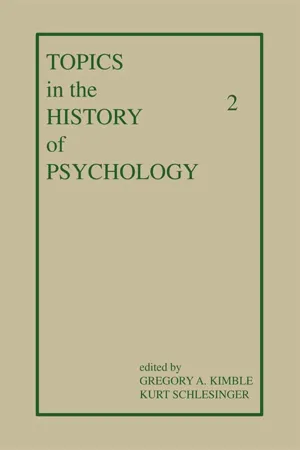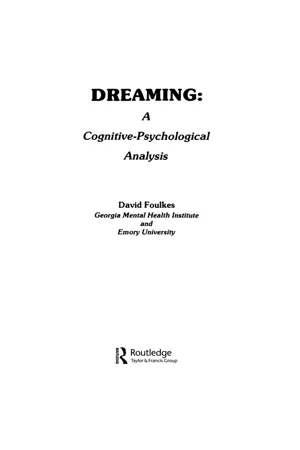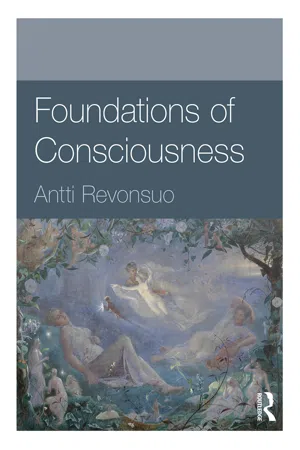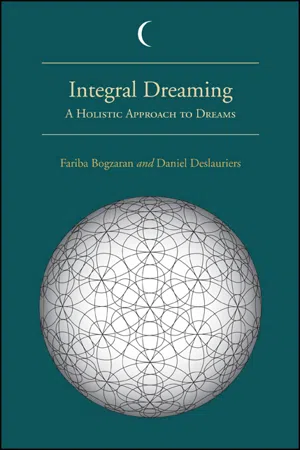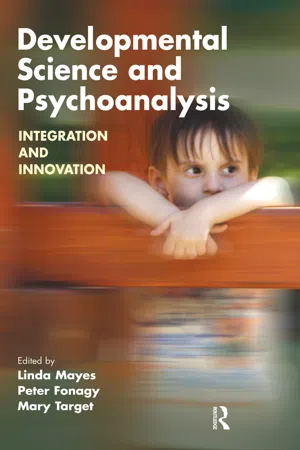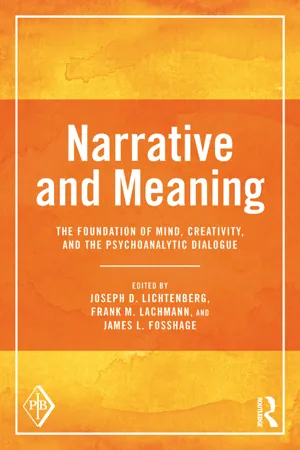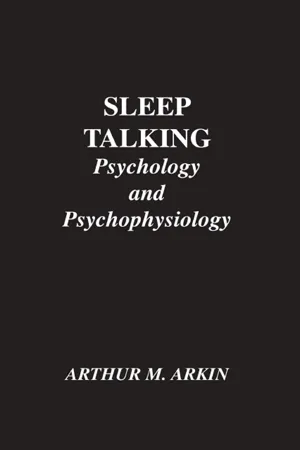Psychology
Sleep and Dreaming
Sleep is a natural state of rest characterized by reduced sensory awareness and voluntary muscle activity. Dreaming occurs during the rapid eye movement (REM) stage of sleep and involves vivid sensory experiences and emotional content. Both sleep and dreaming play important roles in cognitive function, emotional regulation, and overall well-being.
Written by Perlego with AI-assistance
Related key terms
8 Key excerpts on "Sleep and Dreaming"
- eBook - ePub
Topics in the History of Psychology
Volume II
- G. A. Kimble, K. Schlesinger(Authors)
- 2014(Publication Date)
- Psychology Press(Publisher)
This theory marks yet another point in the constant struggle to bridge the mind-body issues sharpened by the advancing discoveries about the central nervous system. Freud (1900/1965) had found it necessary in his approach to take a different position: “Scientific theories of dreams have no room for any problem of interpreting them, since in their view a dream is not a mental act at all, but a somatic process signalling the occurrence by indications registered on the mental appratus” (p. 128).It can be reasonably guessed that the relationships between neurophysiological correlates of sleep and the mental states associated with sleep as precursors, concomitants, and consequences will remain as fundamental challenges.CONCLUSIONFrom this review of sleep and dreams, it is clear that these areas have not been of central concern in the development of contemporary psychology. They remain of peripheral interest. Of the 13,800 articles appearing in the Psychological Abstracts from January through June, 1981, 218 were indexed under “sleep” and 45 under “dreams.”The apparent lack of interest in these topics is puzzling. As a behavioral event, sleep constitutes roughly a third of the daily behavior of a human adult and two-thirds of that of a neonate. Furthermore, it is a condition before which all other behaviors bow down when it is present and which modifies behavior when it is wanting. As a state of mind, sleep is clearly psychologically challenging; it is a reversible and differentially responsive period of “non-mind,” as well as a breeding ground for a “third” state of unconsciousness, the dream.There are a few obvious contributors to this neglect. Much of the development of contemporary psychology, certainly from the 1920s, has been ordained by behaviorism (of both a small “b” and a large “B” type). From this perspective, sleep has limitations. Is this non-behaving really a behavior? Even if considered a “behavior,” it is sharply restricted in its variability. More critically, at the core of behaviorism’s concern is the mutability or modifiability of the behavior. Sleep is not a response controlled by learning or desire. In this context, sleep is likely to be viewed as a biological system such as digestion or the circulation of the blood—a homeostatic system with limited responsivity to learning, reinforcement, or motivation. Those interested in the sensory or information input side of psychology see their interests disappear with the onset of sleep. In short, sleep can be viewed as a variable which fits neither our theoretical conceptions nor our methods of study. - eBook - ePub
Dreaming
A Cognitive-psychological Analysis
- David Foulkes(Author)
- 2014(Publication Date)
- Routledge(Publisher)
any mental experience occurring during sleep. We now see that such an all-inclusive definition is not very helpful in either describing or explaining the mind’s activities during sleep. However, it’s been difficult to come up with an acceptable system for classifying these activities.2. Dreaming and Non-Rem SleepConsider, for example, the variety of experiences people can report on non-REM awakenings. Significantly more often than on REM awakenings (in one study, on fully 20% of all non-REM awakenings10 ), subjects report “thinking” about something. They’re not simulating life, they’re just thinking about some aspect of it. Fairly often, the object of their thought is some aspect of their workaday world: an I.R.S. employee contemplates the amount of support you need to claim someone as a dependent, or a student “thinks” about an upcoming examination. Sometimes, the object of their thought is described topically rather than in any way that lends itself to propositional analysis: “I was thinking of Italy.” (Of what about Italy? The subject seems not to know.) What these “thinking” reports often seem to have in common is that, paradoxically, they don’t give evidence of much thinking. That is, subjects describe the object of their mental concern, but they typically don’t describe having done much real thinking about it. They haven’t actively thought through anything; their thinking has not been to any particular point or in the service of any particular goal. Occasionally, the lack of active, constructive thinking is so striking that the subject describes the experience as simply remembering, rather than thinking about, some real-life situation (“I was rehearsing my parents’ conversation with me on the phone last night”). “Remembering” reports also are given significantly more frequently on non-REM than on REM awakenings.11 - eBook - ePub
- Antti Revonsuo(Author)
- 2017(Publication Date)
- Routledge(Publisher)
The cognitive-psychological view of dreaming was based on large studies of dream reports that had been systematically collected in sleep laboratories or carefully recorded in home dream diaries, and then analyzed by their contents with content analysis methods such as the Hall and Van de Castle method. The cognitive approach criticized the Activation–Synthesis view of dreaming as being based more on stereotypical anecdotes and biased memories of dreams, not on proper representative samples of dreams collected for research purposes.Thus, in the 1980s and with the rise of the cognitive approach in particular, dreaming was again taken seriously as a form of consciousness or subjective mental experience in psychology. Dream experience was again studied systematically by looking at detailed introspective dream reports. Dreaming was to be explained by either the underlying cognitive or neural mechanisms, or both in combination. With the advent of cognitive neuroscience and consciousness studies in the 1990s, scientific dream research became a natural part of these fields. Also, philosophers became newly interested in the relationships between dreaming, consciousness, and the brain (Revonsuo, 2006; Windt, 2015).p.110This development is fortunate for modern consciousness research because ASCs related to Sleep and Dreaming are the most commonly occurring altered states in normal adults, and hence a most valuable source of data and evidence about consciousness. We sleep about eight hours per day or one third of our lives. It is sometimes mistakenly stated that when we are asleep we are not conscious at all, but most of the time that we spend sleeping we are in fact in some kind of altered state of consciousness rather than totally unconscious. Next we will take a look at the rich variety of ASCs that occur during sleep.Hypnagogic and hypnopompic hallucinations“Hypnagogia” is the brief transitional state from wakefulness to sleep (literally, “leading to sleep”). The internally generated images in this state are called hypnagogic hallucinations. By contrast, hypnopompic hallucinations (meaning literally, “leading out of sleep”) occur in the transitional state from sleep back to wakefulness.The contents of the hallucinations are quite similar in both stages. According to one explanation of these ASCs, the mechanisms of REM sleep that normally produce dream images are activated when the brain is just about to lose or gain the state of wakefulness. The result is an ASC that combines some features of wakefulness with some features of dreaming. - Nancy Fenton, Jessica Flitter(Authors)
- 2015(Publication Date)
- Research & Education Association(Publisher)
hidden until it is needed.According to the information-processing theory , a cognitive approach, dreams are methods that the mind uses to sort out the events of the day and place them into memory. It is known that REM sleep, for example, is positively correlated with memory retention. In experiments, if participants are awakened during REM, their recall of information is much worse than the recall of participants who were able to receive a restful night of sleep. It is believed that REM sleep may play a critical role in the ability of the brain to consolidate memory. Cognitive psychologists also suggest that the dreaming associated with REM is involved in the process of placing and organizing thoughts into long-term memory.The purpose of dreams has also been examined from the biological perspective. McCarley and Hobson proposed the activation–synthesis hypothesis , which states that dreams are merely the result of the forebrain attempting to interpret the stimulation it is receiving during sleep. According to this theory, signals from the brainstem, especially the pons, are reaching areas of the cortex in charge of vision, hearing, and memory, and the forebrain is working to create meaning from these limited messages, resulting in what we experience as dreams. Other biological theories suggest that dreams occur because some activation during the long period of sleep is needed to create and maintain neural connections.HypnosisHypnosis was first popularized in the late eighteenth century by a Viennese physician named Anton Mesmer, and the method was used for some time by Freud in an attempt to reach the unconscious. Hypnosis is considered by some psychologists to be an altered state of consciousness that utilizes the power of suggestion. Hypnotized subjects experience a relaxed mental state and lack the ongoing stream of consciousness, which occurs in most waking states. Psychologists agree that hypnosis is not a form of sleep because hypnotic subjects’ EEG activity indicates that they are in an awake and active state. However, there is disagreement among psychologists regarding whether or not hypnosis is, in fact, a distinct state of consciousness. Individuals under hypnosis are generally believed to be in a state of high suggestibility; they more readily accept instruction and information from the hypnotist, even sometimes bizarre instructions. Suggestibility varies among individuals, and, in general, children are more suggestible than adults, and individuals who are more daydream- or fantasy-prone may have higher levels of suggestibility. Posthypnotic suggestion refers to the idea that statements made by a hypnotist, while a person is hypnotized, will be able to influence the person’s behavior later. Posthypnotic amnesia is the phenomenon of individuals not being able to remember what transpired while they were hypnotized. Dramatic claims related to posthypnotic suggestion and posthypnotic amnesia are not supported by research. Additionally, the use of hypnosis as a tool to improve memory or recall the past is not effective. One area of hypnosis that has shown promise is hypnotic analgesia- eBook - ePub
Integral Dreaming
A Holistic Approach to Dreams
- Fariba Bogzaran, Daniel Deslauriers(Authors)
- 2012(Publication Date)
- SUNY Press(Publisher)
Dreams contribute significantly in these two different but complementary ways. First, they arise naturally as part of the sleep-wake cycle; whether or not we reflect on them, dreams play a crucial role in the self-regulation of the organism, particularly regarding mood. They also play an essential role in memory consolidation and the learning process. Scientific findings further suggest that the complex processing taking place in dreams pertains to what is emotionally relevant to the dreamer. REM dreaming may be one of the creative ways the brain has found to extract value, find patterns, and compare and contrast emotional memories and rehearse scenarios. In other words, dreaming may help integrate and metabolize experience. Just as virtual reality enables immersive involvement, dreaming can show us “what it is like” to have certain experiences. In this way, dreaming also allows an exploration of possible selves (Kahan, 2011). Second, dreams are open to the process of self-reflection. By focusing on the mind aspect of the brain-mind equation, the importance of attention awareness comes to light. Varying forms of self-modulation can interact with dream consciousness. By means of self-reflection and self-regulation—either within the dream itself (lucid dreaming), or by working with dreams in the waking state, the dreaming state can help the self to know itself better. In this way, dreams are both autopoietic and autonoetic, generating new patterns of thoughts and potential insights into behavioral patterns wherein the self can understand, transform, and even heal itself. CHAPTER FIVE The Subjective Experience of Dreams From the private confines of the mind sealed by sleep, dreams coalesce as the wondrous display of the inner worlds. There, subjectivity reigns supreme: dreaming is a singular, creative, and utterly personal experience - eBook - ePub
Developmental Science and Psychoanalysis
Integration and Innovation
- Peter Fonagy, Linda Mayes, Mary Target(Authors)
- 2018(Publication Date)
- Routledge(Publisher)
Chapter Five The Interpretation of Dreams and the neurosciencesMark SolmsShortly after Freud’s death, the study of dreaming from the perspective of neuroscience began in earnest. Initially, these studies yielded results that were difficult to reconcile with the psychological conclusions set out in his great book, The Interpretation of Dreams (1900a). The first major breakthrough came in 1953, when Aserinsky and Kleitman discovered a physiological state that occurs periodically (in 90-minute cycles) throughout sleep and occupies approximately a quarter of our sleeping hours. This state is characterized, among other things, by heightened brain activation, bursts of rapid eye movement (REM), increased breathing and heart rate, genital engorgement, and paralysis of bodily movement. It consists, in short, in a paradoxical physiological condition in which one is simultaneously highly aroused and yet fast asleep. Not surprisingly, Aserinsky and Kleitman suspected that this REM state (as it came to be known) was the external manifestation of the subjective dream state. That suspicion was soon confirmed experimentally (Aserinsky & Kleitman, 1955; Dement & Kleitman, 1957a, 1957b). It is now generally accepted that if someone is awakened from REM sleep and asked whether or not they have been dreaming, they will report that they were dreaming in as many as 95% of such awakenings. Non-REM sleep, by contrast, yields equivalent dream reports at a rate of only 5–10% of awakenings.These early discoveries generated great excitement in the neuroscientific field: for the first time it appeared to have in its grasp an objective, physical manifestation of dreaming, one of the most subjective of all mental states. All that remained to be done, it seemed, was to lay bare the brain mechanisms that produced this physiological state; then we would have discovered nothing less than how the brain produces dreams. Since the REM state can be demonstrated in almost all mammals, this research could also be conducted in nonhuman species (which has important methodological implications, for brain mechanisms can be manipulated in animal experiments in ways that they cannot in human research). - eBook - ePub
Narrative and Meaning
The Foundation of Mind, Creativity, and the Psychoanalytic Dialogue
- Joseph D. Lichtenberg, Frank M. Lachmann, James L. Fosshage(Authors)
- 2017(Publication Date)
- Routledge(Publisher)
The dream narrativeJames L. Fosshage, PhDDreaming continues at night the process of encoding and logging experience into memory and organizing lived experience into meaningful narratives. From today’s contemporary perspective, dreaming provides an array of developmental, regulating and organizing functions that parallels waking thought far more than previously conceived. Dreaming, especially NREM dreams, can be quite focused on problem solving of waking tasks, for example, a new sentence in a manuscript or needing to shovel the snow on the drive-way. Dreaming, especially REM dreams, can provide a narrative that has an overall emotionally balancing impact, for example, a restoration of self-esteem.Dreaming continues the process of creating, altering and repeating narratives that are “the building blocks of the development of the human psyche” (see p. 1 ). REM dreams, utilizing imagistic symbolic processing of the right brain, can organize lived experience in a deeply holistic and integrated narrative that regulates and furthers psychological development. This perspective on dreaming has emerged through a number of theoretical contributors to contemporary psychoanalysis who have challenged the classical assumption of ubiquitous defensive functioning and corresponding manifest/latent content distinction. These theorists have re-conceptualized primary process so that it is no longer a primitive process and have variably integrated developments within cognitive science, neuroscience and dream content research. Thus, a new perspective on dreams has emerged supporting the coherence, logic of imagistic sequences and metaphoric salience of the dream narrative.Human beings, as well as all other mammals, birds, and even reptiles experience cycling periods of REM sleep (Shein-Idelson, et al - eBook - ePub
Sleep Talking
Psychology and Psychophysiology
- A. M. Arkin(Author)
- 2018(Publication Date)
- Psychology Press(Publisher)
18 Sleep-Talking in Relation to Cognitive Psychology: Memory, Psycholinguistics, and AphasiaThe scientific literature dealing with wakeful cognition is intimidatingly huge. Until 1953, when the new electrographic sleep research era was inaugurated by Aserinsky, Kleitman, and Dement, cognition in sleep was by contrast unexplored; and even now, only the surface has been lightly touched. Most of the leading and influential ideas arose in clinical settings, and Freud’s theories of dream formation and psychic structure dominated the field and have by no means lost much of their usefulness nor influence. As stated elsewhere (Arkin, Antrobus, & Ellman, 1978a), the data base of theories of sleep cognition has been and will continue to be sleep mentation reports, including those of vivid dreams as a special subset. It naturally follows that sleep-utterance lends itself as both an independent and adjunctive source of empirical material to be included in such a data base. A study of the form, content, and correlates of sleep-utterance is rich territory. Three areas of cognitive psychology to which sleep-utterance seems relevant are the ontological status of sleep mentation, the study of memory mechanisms, and psycholinguistics, and we comment on some points of contact between them. But first we must deal with a fundamental issue—in what senses may we say that when a person somniloquizes, he is in fact “talking in his sleep?”SLEEP-UTTERANCE AS UTTERANCE DURING SLEEPIt is necessary to state at once that a universally accepted unambiguous definition of sleep has not yet been formulated. Although polygraphic parameters, particularly those derived from the combined use of the EEG, submental EMG, and EOG, have been used by sleep researchers (providing the most pragmatic criteria yet available), there are, nevertheless, exceptions and transitional states that are not conveniently subsumed under them. Examples are the “phases intermédiares
Learn about this page
Index pages curate the most relevant extracts from our library of academic textbooks. They’ve been created using an in-house natural language model (NLM), each adding context and meaning to key research topics.
